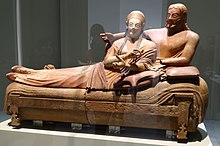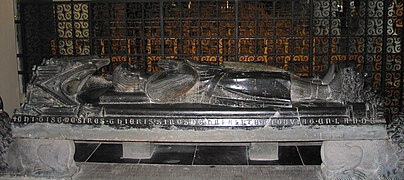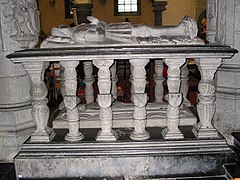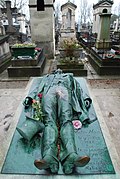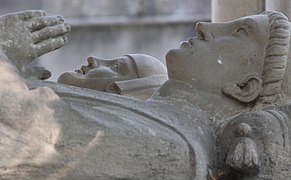Gisant
Gisant (French "recumbent", German also reclining figure ) is the art-historical technical term for the sculptural design of a lying dead on a sarcophagus or cenotaph .

history

Antiquity
Already on Etruscan and Roman tombs or wall paintings the deceased are depicted lying down, but not as dead, but in a similar way to a banquet ( symposium ): the upper body is supported on an angled arm, the head with open eyes is turned towards the viewer.
The two anthropomorphic Phoenician sarcophagi from Cadiz , on the other hand, show the type of a real reclining figure. While the head is fully sculpted with closed eyes , the arms and hands, worked as a bas-relief , rest on the body.
middle Ages
The origin of the medieval reclining figures ( gisants ) is controversial in research: some see ancient influences, others are of the opinion that the oldest medieval specimens are geographically and iconographically far too far removed from the few ancient representations that have survived.
The earliest known example of a medieval reclining figure is the tomb of the anti-king Rudolf of Swabia in Merseburg Cathedral (after 1080), where the deceased - as if standing upright - is depicted in a high relief made of bronze and with the imperial insignia in his hands on the grave plate. Comparable to this is the somewhat later and artistically developed grave slab of the alleged sarcophagus for the Saxon Duke Widukind in the Enger collegiate church (after 1100).
From the early relief portraits, over the course of time, a more and more fully sculptural representation developed.
Renaissance
The Roman-Etruscan type has appeared again since the Renaissance (cf. Gisant des Philippe Chabot ), but remains limited to individual cases compared to the medieval reclining figure.
development
The earliest medieval gisants still depict the figure in question as if it were standing (recognizable, among other things, by the missing pillow). Later the honored deceased were depicted as lying on a bed, but often as if they were still alive (recognizable by their open eyes or by activities). All dead of this epoch are not shown in their actual age at the time of their death, but in the prime of their years.
In early depictions, the dead man's feet sometimes rest on a stone slab, then on a console or a pillow; later a dog can often be seen at the feet of the lying figure - it symbolizes the marital fidelity of the deceased. In men, instead of the dog, there is often a lion as a symbol of the strength or worldly power of the dead.
From the 14th century onwards, the male deceased could be depicted on their sarcophagi in a very realistic way as having just fallen asleep (e.g. with sunken eyes), as decaying or even as a skeleton. The French technical term for such a representation is transi - a term that is rarely used in German. This type of representation is unusual for women.
Examples
Germany
- 11th century
- Grave slab of Rudolf of Swabia in Merseburg Cathedral (after 1080)
- 12th Century
- Grave slab of the Saxon Duke Widukind (8th century) in the collegiate church Enger (after 1100)
- Grave slab of the plectrudis (7th / 8th centuries) in St. Maria im Kapitol , Cologne (around 1160/70)
- 13th Century
- Tombs of Henry the Lion (around 1130–1189) and his wife Mathilde (around 1155–1189) in the Brunswick Cathedral (around 1225/30)
- 14th Century
- Gisant of Bishop Konrad von Hochstaden (around 1205–1261) in Cologne Cathedral
Two important epitaphs should also be mentioned:
- 15th century
- Tomb of Prince-Bishop Rudolf II von Scherenberg (around 1401–1495) in the Würzburg Cathedral (around 1496/99)
- 16th Century
- Tomb of Prince-Bishop Lorenz von Bibra (1459–1519) in the Würzburg Cathedral (around 1520)
France

- 11th century
- 12th Century
- Gisant of King Philip I (1052–1108) in the Fleury Abbey in Saint-Benoît-sur-Loire
- Gisant on the grave of Duke Wilhelm VIII of Aquitaine (1027–1086), Poitiers , Église Saint-Jean de Montierneuf
- 13th Century
- Gisants von Heinrich II. Plantagenêt (1133–1189), Eleanor of Aquitaine (1122–1204) and Richard the Lionheart (1157–1199) in the Abbey of Fontevraud
- Wooden Gisant of Isabella of Angoulême (1188–1246) in the Abbey of Fontevraud
- 14th Century
- Copper Gisant of the Blanche de Champagne-Navarre (1226–1283), Duchess of Brittany, Abbey of the Canton of Hennebont , now in the Louvre
- Marble gisants of the dukes Johann II. (1239–1305) and Johann III. Brittany (1286-1341) in the church of Ploërmel
- Heart tomb for Charles I of Anjou (1227–1285) in the Saint-Denis basilica
- Granite Gisant by Johanna (? -1388), heiress of Brittany, in the abbey church of Saint-Gildas-en-Rhuys
- 15th century
- Tombs of the Burgundian dukes Philip II (1342–1404) and Johann Ohnefurcht (1371–1419), Dijon , museum in the Palais des Ducs et des États de Bourgogne
- Gisant Ludwigs von Sancerre (1341–1402) in the cathedral of Saint-Denis
- Gisant of Agnès Sorel (1422–1450) in the collegiate church of Saint-Ours of Loches

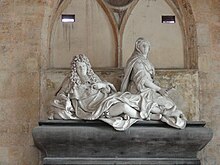
- 16th Century
- Gisants of the Breton Duke Francis II (1435–1488) and his 2nd wife Marguerite de Foix (around 1459–1486), the parents of Anne de Bretagne , in the cathedral of Nantes
- Marble Gisants of Anne de Bretagne (1477–1514) and her husband, King Louis XII. (1462–1515), in the Cathedral of Saint-Denis
- Double tombs of Philibert II of Savoy (1480–1504) and his wife Margaret of Austria (1480–1530) in the church of Brou in Bourg-en-Bresse
- Gisant by Philippe Chabot (1492–1543), Admiral of France , now in the Louvre
- Gisants of members of the Gouffier family in the collegiate church of Oiron , Poitou
- 17th century
- Gisant of François Michel Le Tellier de Louvois (1641–1691), Louis XIV's Minister of War, in the Hôtel-Dieu in Tonnerre , Burgundy
- 18th century
- 19th century
- Marble tomb of François Fénelons (1651–1715) in the Cathedral of Cambrai by David d'Angers (1826)
- Bronze Gisant (1891) by the Republican Victor Noir in the Pere Lachaise Cemetery in Paris
- Gisants Heloisas (1095–1164) and Abelards (1079–1142) in the Père Lachaise cemetery in Paris
Catalonia
- 13th Century
- Tomb of Wilhelm de Jordan, Elne , Roussillon
- 14th Century
- Tombs of the kings of Aragon in the former Cistercian abbey of Poblet
Spain
- 12th Century
- Gisant Raimunds of Burgundy (around 1070–1107) in the Cathedral of Santiago de Compostela
- 16th Century
- Gisants of the Catholic Kings Isabella I (Castile) (1451–1504) and Ferdinand II (Aragón) (1452–1516) in the Capilla de los Reyes, Granada
- Tombs of the kings of Najéra-Pamplona in the monastery of Santa María la Réal in Nájera
Portugal
- 14th Century
- Tombs of King Pedro I (1320–1367) and his lover Inês de Castro (around 1320–1355) in the monastery of Alcobaça
- 15th century
- Tombs of the Portuguese ruling family of the House of Avis in Batalha Monastery
- 16th Century
- Tombs of Alfonso I (around 1109–1185) and his son Sancho I (1154–1211) in the Santa Cruz Monastery in Coimbra
Austria
- 14th Century
- Double grave of Rudolf IV (1339–1365) and Catherine of Luxembourg (1342–1395), St. Stephen's Cathedral , Vienna (around 1360)
- 16./17. century
- Cenotaph in the Habsburg mausoleum (1587–1611 / 12) of the Seckau basilica , Styria : Karl II. Franz von Innerösterreich (1540–1590) and Maria Anna von Bayern (1551–1608)
Belgium
- 13th Century
- Gisant Thierrys II. († 1282), Église Ste-Catherine, Houffalize
- Gisant of the Sibyl of Lusignan († 1187), sister of King Baldwin IV of Jerusalem , in Namêche
- 16th Century
- Gisants of Johann III. von Trazegnies († 1550) and his wife Isabel von Werchin († 1559), Church of St. Martin, Trazegnies
- Gisant of an unknown in Boussu , sculptor Jacques du Broeucq
- 17th century
- Marble gisant of the provost Conrad de Gavre († 1602) in the Basilica of Saint Martin in Liège
- Gisants by Gillion-Othon de Trazegnies († 1669) and his wife Jacqueline de Lalaing, Church of St. Martin, Trazegnies
England
- 13th Century
- Tomb of William Marshal, 1st Earl of Pembroke (1144–1219), Temple Church , London
Italy
- 14th Century
- Tomb of Bruno Beccuti, Florence, Santa Maria Maggiore
- 15./16. century
- Papal tombs in St. Peter's Basilica , Rome
Poland
- 14th Century
- Tomb of Heinrich IV. , Originally in the Kreuzkirche , Breslau
- gallery
Gisant Thierrys II of Houffalize (13th century)
Gisants of Johann III. von Trazegnies and his wife Isabel von Werchin (16th century) in Trazegnies , including a Transi
Gisant of an unknown in Boussu , Jacques du Broeucq (16th century)
Gisants by Gillion-Othon de Trazegnies and his wife Jacqueline de Lalaing (17th century) in Trazegnies
Gisant des Victor Noir in the Père-Lachaise cemetery (19th century)
literature
- Johan Huizinga: Autumn of the Middle Ages. Studies of forms of life and spirit in the 14th and 15th centuries in France and the Netherlands. Drei Masken Verlag, Munich 1924.
- Kurt Bauch: The medieval grave picture. Figurative grave images from the 11th to 15th centuries in Europe. De Gruyter, 1976, ISBN 3-11-004482-X .
- Philippe Ariès : Studies on the History of Death in the Occident. dtv, Munich 1986, ISBN 3-423-04369-5 .
- Philippe Ariès: History of Death . dtv, Munich 2005, ISBN 3-423-30169-4 .
- Philippe Ariès: Images on the History of Death . Hanser-Verlag, Munich / Vienna 1984, ISBN 3-446-13911-7 .
- Barbara Tuchman : The Distant Mirror. The dramatic 14th century. Claasen-Verlag, Düsseldorf 1980, ISBN 3-546-49187-4 .
- Mark Duffy: Royal Tombs of Medieval England. History Press, London 2003, ISBN 0-7524-2579-X .
- Hans Körner: Grave monuments of the Middle Ages. Primus-Verlag, Darmstadt 1997, ISBN 3-89678-042-5 .
- Françoise Baron: Le médecin, le prince, les prélats et la mort. L'apparition du transi dans la sculpture française du Moyen Âge Cahiers archéologiques, Numéro 51. Paris, Picard, 2006, pp. 125–158.
Web links
- Remnants of a tomb slab from the 11th century in the Hildesheim Cathedral - photo + information
- The Gisants of the Cathedral of Saint-Denis - photos + info (in French)
- The Gisants of Fontevraud - photo
- Tomb of Bishop Ramon de Costa in the Cathedral of Elne - Photo + info (French)
- Effigies and Brasses - Photos and information (Engl.)
- statua loricatus - Photos and information (Engl.)
